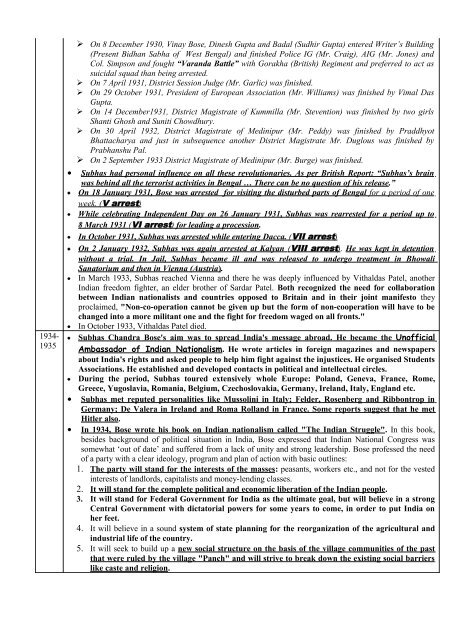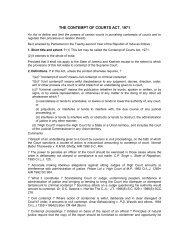You also want an ePaper? Increase the reach of your titles
YUMPU automatically turns print PDFs into web optimized ePapers that Google loves.
1934-<br />
1935<br />
� On 8 December 1930, Vinay Bose, Dinesh Gupta and Badal (Sudhir Gupta) entered Writer’s Building<br />
(Present Bidhan Sabha of West Bengal) and finished Police IG (Mr. Craig), AIG (Mr. Jones) and<br />
Col. Simpson and fought “Varanda Battle” with Gorakha (British) Regiment and preferred to act as<br />
suicidal squad than being arrested.<br />
� On 7 April 1931, District Session Judge (Mr. Garlic) was finished.<br />
� On 29 October 1931, President of European Association (Mr. Williams) was finished by Vimal Das<br />
Gupta.<br />
� On 14 December1931, District Magistrate of Kummilla (Mr. Stevention) was finished by two girls<br />
Shanti Ghosh and Suniti Chowdhury.<br />
� On 30 April 1932, District Magistrate of Medinipur (Mr. Peddy) was finished by Praddhyot<br />
Bhattacharya and just in subsequence another District Magistrate Mr. Duglous was finished by<br />
Prabhanshu Pal.<br />
� On 2 September 1933 District Magistrate of Medinipur (Mr. Burge) was finished.<br />
• Subhas had personal influence on all these revolutionaries. As per British Report: “Subhas’s brain<br />
was behind all the terrorist activities in Bengal … There can be no question of his release.”<br />
• On 18 January 1931, Bose was arrested for visiting the disturbed parts of Bengal for a period of one<br />
week. ( V arrest)<br />
• While celebrating Independent Day on 26 January 1931, Subhas was rearrested for a period up to<br />
8 March 1931 ( VI arrest)<br />
for leading a procession.<br />
• In October 1931, Subhas was arrested while entering Dacca. ( VII arrest)<br />
• On 2 January 1932, Subhas was again arrested at Kalyan ( VIII arrest)<br />
. He was kept in detention<br />
without a trial. In Jail, Subhas became ill and was released to undergo treatment in Bhowali<br />
Sanatorium and then in Vienna (Austria)<br />
.<br />
• In March 1933, Subhas reached Vienna and there he was deeply influenced by Vithaldas Patel, another<br />
Indian freedom fighter, an elder brother of Sardar Patel. Both recognized the need for collaboration<br />
between Indian nationalists and countries opposed to Britain and in their joint manifesto they<br />
proclaimed, "Non-co-operation cannot be given up but the form of non-cooperation will have to be<br />
changed into a more militant one and the fight for freedom waged on all fronts."<br />
• In October 1933, Vithaldas Patel died.<br />
• Subhas Chandra Bose's aim was to spread India's message abroad. He became the Unofficial<br />
Ambassador of Indian Nationalism. He wrote articles in foreign magazines and newspapers<br />
about India's rights and asked people to help him fight against the injustices. He organised Students<br />
Associations. He established and developed contacts in political and intellectual circles.<br />
• During the period, Subhas toured extensively whole Europe: Poland, Geneva, France, Rome,<br />
Greece, Yugoslavia, Romania, Belgium, Czechoslovakia, Germany, Ireland, Italy, England etc.<br />
• Subhas met reputed personalities like Mussolini in Italy; Felder, Rosenberg and Ribbontrop in<br />
Germany; De Valera in Ireland and Roma Rolland in France. Some reports suggest that he met<br />
Hitler also.<br />
• In 1934, Bose wrote his book on Indian nationalism called "The Indian Struggle" . In this book,<br />
besides background of political situation in India, Bose expressed that Indian National Congress was<br />
somewhat ‘out of date’ and suffered from a lack of unity and strong leadership. Bose professed the need<br />
of a party with a clear ideology, program and plan of action with basic outlines:<br />
1. The party will stand for the interests of the masses:<br />
peasants, workers etc., and not for the vested<br />
interests of landlords, capitalists and money-lending classes.<br />
2. It will stand for the complete political and economic liberation of the Indian people.<br />
3. It will stand for Federal Government for India as the ultimate goal, but will believe in a strong<br />
Central Government with dictatorial powers for some years to come, in order to put India on<br />
her feet.<br />
4. It will believe in a sound system of state planning for the reorganization of the agricultural and<br />
industrial life of the country.<br />
5. It will seek to build up a new social structure on the basis of the village communities of the past<br />
that were ruled by the village "Panch" and will strive to break down the existing social barriers<br />
like caste and religion.




